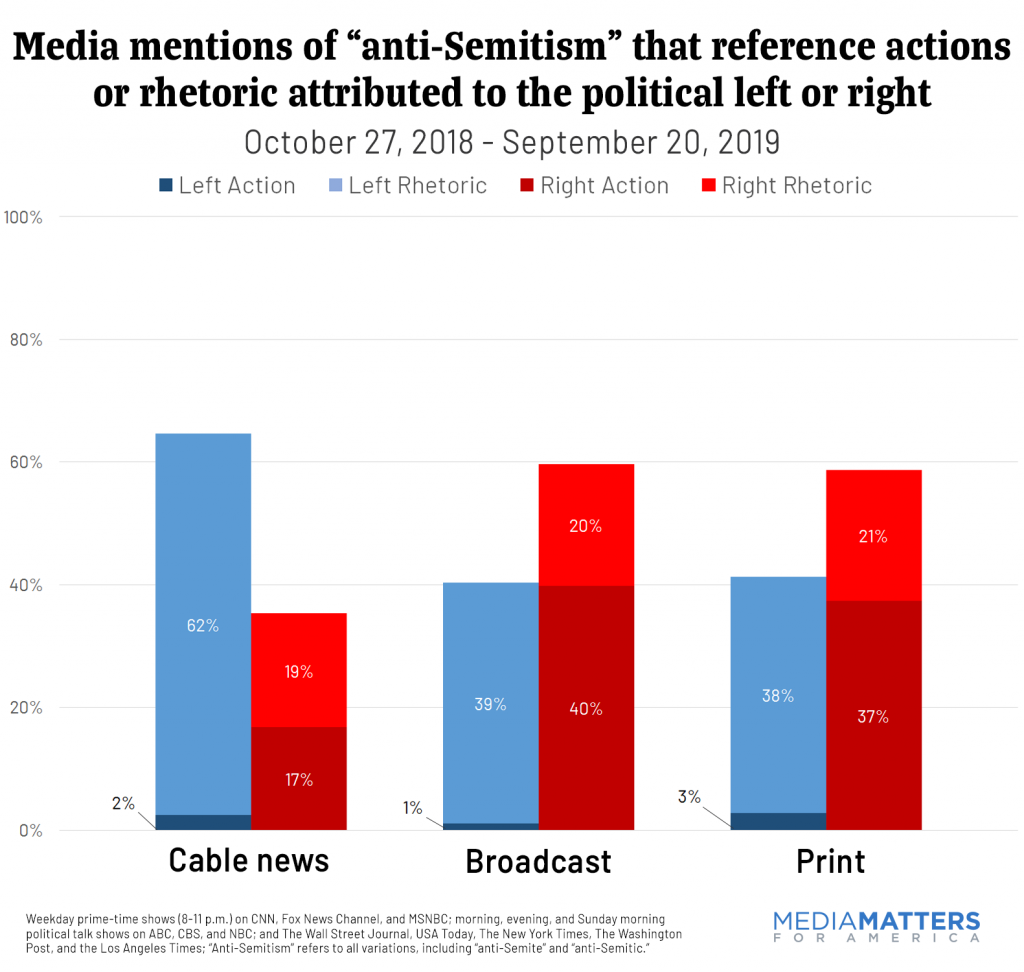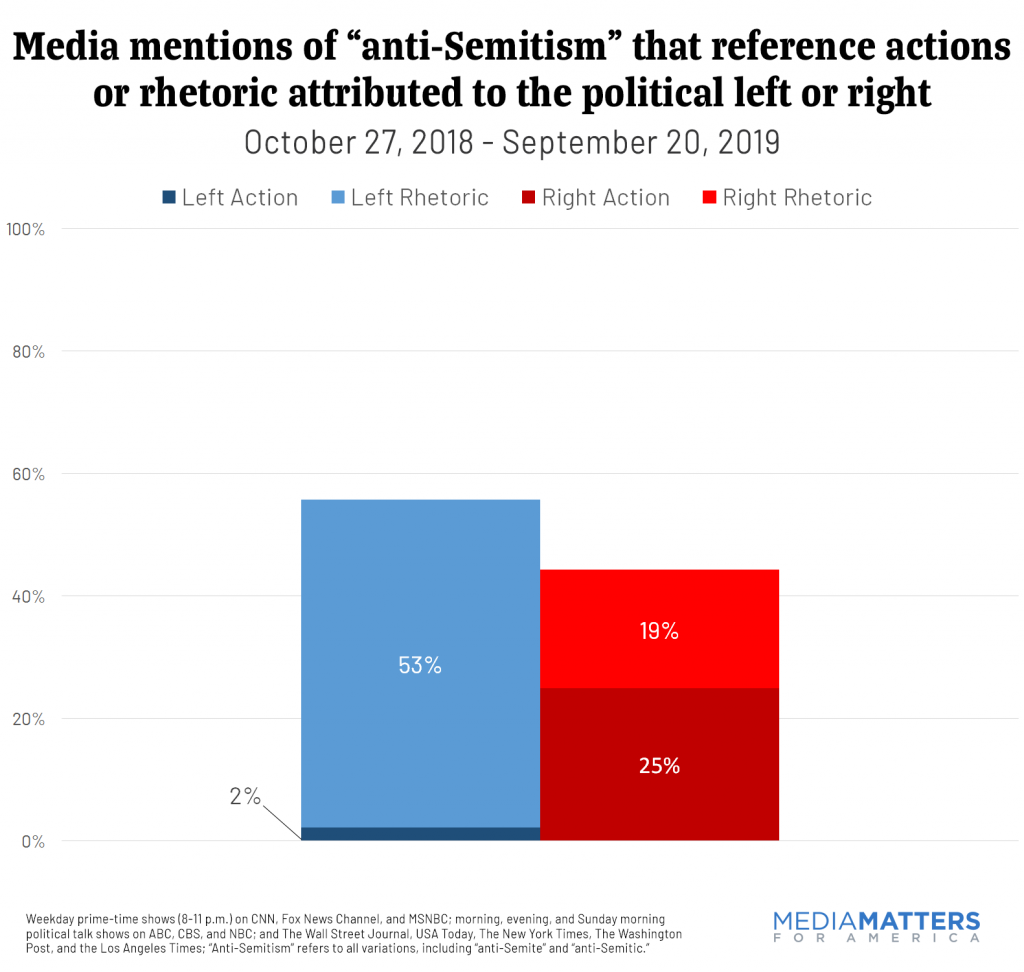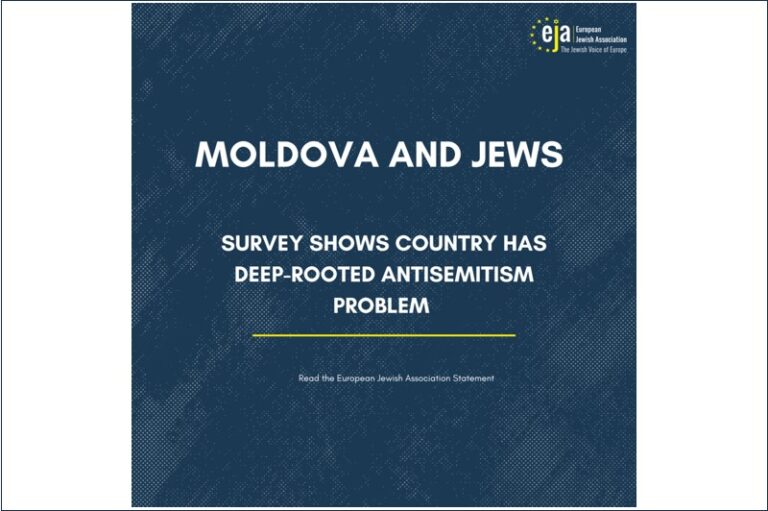Source: Media matters
Following the Tree of Life synagogue shooting, media outlets have mentioned perceived antisemitic rhetoric from the political left more than antisemitic actions by the right-wing
In the nearly 11 months following the massacre at the Tree of Life synagogue in Pittsburgh in which the alleged gunman, Robert Bowers, killed 11 people and injured six others, news media have more often mentioned antisemitism in reference to the political left than the right — 56% to 44%, respectively.
Yet reporting from The Pittsburgh Post-Gazette paints a picture of a gunman steeped in conservative and white nationalist circles. The paper describes Bowers’ fascination with conservative radio show host Jim Quinn and “aggressive online provocateurs of the right wing’s fringe.” He also promoted antisemitic conspiracy theories online and posted on Gab, a social media platform known for its far-right community. And Bowers was not the only far-right extremist to commit acts of violence in 2018: The Anti-Defamation League noted that “right-wing extremists were responsible for 49 (or 98%) of the 50 domestic extremist-related killings” that year.
Despite this reality of deadly antisemitic acts perpetuated by far-right white supremacists, media not only referenced perceived antisemitism on the left more often than antisemitism on the right, they specifically mentioned rhetoric from the left, such as comments from freshmen Reps. Ilhan Omar (D-MN) and Rashida Tlaib (D-MI) that were characterized as antisemitic, more often than they did antisemitic acts of violence and other actions from the right, such as the shootings at the Pittsburgh and Poway synagogues. Of the total media mentions of antisemitism found, 53% referred to rhetoric from the left while 25% were about acts from the right; an additional 19% of references were about rhetoric from the right.
Despite this reality of deadly antisemitic acts perpetuated by far-right white supremacists, media not only referenced perceived antisemitism on the left more often than antisemitism on the right, they specifically mentioned rhetoric from the left, such as comments from freshmen Reps. Ilhan Omar (D-MN) and Rashida Tlaib (D-MI) that were characterized as antisemitic, more often than they did antisemitic acts of violence and other actions from the right, such as the shootings at the Pittsburgh and Poway synagogues. Of the total media mentions of antisemitism found, 53% referred to rhetoric from the left while 25% were about acts from the right; an additional 19% of references were about rhetoric from the right.
Over the same time, President Donald Trump and other Republicans have been “weaponizing” charges of antisemitism by expressing outrage over comments perceived as antisemitic from Democratic lawmakers — despite Trump’s own history of using antisemitic rhetoric and continually tweeting dog whistles that contain antisemitic tropes. Media unwittingly aid this right-wing strategy when they present a false equivalency between perceived antisemitic rhetoric from the left and deadly right-wing antisemitic violence.
Key Findings
- Across all media studied, we found more references to antisemitism attributed to the left – 56% – than to the right – 44%.
- Regardless of political attribution to the reference, media have focused on antisemitic rhetoric far more than antisemitic actions: 1,406 of all references to antisemitism were about rhetoric, and 525 instances were about actions.
- When media outlets referenced antisemitic rhetoric, they were far more likely to be referencing rhetoric from the left than from the right, with 73% of all references to antsemitic rhetoric being attributed to the left.
- Media have focused on antisemitic rhetoric attributed to the left to the same degree as antisemitic actions – violence and other – attributed to the right.
- References to “antisemitic” comments from Rep. Ilhan Omar (D-MN) outnumbered references to “antisemitic” comments from President Donald Trump.
- Fox News accounted for 57% of all antisemitic rhetoric attributed to the left, but even without Fox, media still referred to rhetoric from the left slightly more than antisemitic actions from the right: 37% to 35%, respectively.
Background of antisemitism in the U.S.
The Anti-Defamation League has shown that since 2017, antisemitism is on the rise both in the United States and in Europe: Antisemitic incidents have increased sharply while antisemitic attitudes have slightly increased. In the group’s 2017 Audit of Antisemitic Incidents report, ADL found a 57% increase in total antisemitic incidents from the year prior. And over the last year, several high-profile and clearly antisemitic mass shootings have occurred. ADL’s 2018 audit found “the number of antisemitic assault incidents increased by 105% last year,” which also included the deadliest antisemitic attack in U.S. history, the Tree of Life synagogue shooting.
In congressional testimony delivered last month to the Senate Commerce Committee, the organization described 2018 as having “the highest level of antisemitic incidents with known connections to extremists or extremist groups since 2004.” These incidents included fliering campaigns for right-wing conspiracy theorist Alex Jones by The Daily Stormer Book Clubs, the “on the ground” arm of neo-Nazi website The Daily Stormer, and robocalls in support of white supremacist Patrick Little’s failed Senate bid.
In congressional testimony delivered last month to the Senate Commerce Committee, the organization described 2018 as having “the highest level of antisemitic incidents with known connections to extremists or extremist groups since 2004.” These incidents included fliering campaigns for right-wing conspiracy theorist Alex Jones by The Daily Stormer Book Clubs, the “on the ground” arm of neo-Nazi website The Daily Stormer, and robocalls in support of white supremacist Patrick Little’s failed Senate bid.
Media references to antisemitism
Media generally mentioned perceived “antisemitic” rhetoric from the left at the same rate as “antisemitic” actions from the right
In consultation with the Jewish Electorate Institute, Media Matters reviewed the three broadcast news networks’ nationally syndicated morning shows, evening news shows, and Sunday morning political talk shows; the three cable news networks’ weekday prime-time lineups (shows airing from 8 to 11 p.m.); and five of the top U.S. newspapers for instances of the words “antisemite,” “antisemitic,” and “antisemitism.”
On broadcast news, 39% of references to antisemitism were related to rhetoric from the left while 40% of references were about violent acts and other actions from the right. For print references, 38% were related to rhetoric from the left while 37% were about action from the right. And on cable, 62% of references had to do with rhetoric from the left while 17% of them were about action from the right.
When media cover controversial statements from the left as often as – or even more than – incidents of antisemitic violence, it not only plays into the right-wing weaponization of antisemitism charges, but it also creates a false equivalency between perceived antisemitic rhetoric from the left and actual antisemitic actions – many of them violent or criminal – from the right.

When media cover controversial statements from the left as often as – or even more than – incidents of antisemitic violence, it not only plays into the right-wing weaponization of antisemitism charges, but it also creates a false equivalency between perceived antisemitic rhetoric from the left and actual antisemitic actions – many of them violent or criminal – from the right.

Broadcast news
For broadcast, 39% of newscast mentions of antisemitism had to do with rhetoric from the left, while 40% were about violent acts or other action on the right. An additional 20% of references were to antisemitic rhetoric from the right. Each network was about even on references to antisemitic rhetoric from the left and antisemitic action from the right. CBS had slightly more of the latter – 33% to 39%, respectively – and NBC had slightly more of the former – 44% to 40%, respectively.
Print
In five of the top U.S. newspapers, 38% of references to antisemitism were related to rhetoric from the left while 37% of references were to acts – violent or otherwise -from the right. An additional 21% of references were to antisemitic rhetoric from the right.
The Washington Post stood out for a higher disparity in its coverage of antisemitic rhetoric from the left and antisemitic action from the right: 51% of references were to antisemitic rhetoric from the left and only 27% of references were to antisemitic action from the right. USA Today and the Los Angeles Times stood out for the opposite. In USA Today, 76% of references were to antisemitic action from the right and just 6% of references were to antisemitic rhetoric from the left. For the Los Angeles Times, 47% of references were to antismitic action from the right and 24% of references were to antisemitic rhetoric from the left.
Prime-time cable news
On cable, 62% of references to antisemitism were related to rhetoric from the left while only 17% of references were about violent acts and other actions from the right; 19% of the references were to antisemitic rhetoric from the right.
Fox News skewed the data heavily because the network was responsible for nearly 57% of all references to antisemitic rhetoric from the left across all media studied. To put that number into perspective: Out of a total of 1,406 references to antisemitic rhetoric, 1,033 such references were attributed to the left – and 588 of those were on Fox alone. Without Fox News, the cable data is more in line with overall trends from broadcast and print media: 34% of references to antisemitism related to rhetoric from the left while 31% were about violent acts and other action from the right; 35% of the references were to antisemitic rhetoric from the right.
But on Fox, 82% of references to antisemitism were about rhetoric attributed to the left, while just 7% and 8% of references to antisemitic action and rhetoric, respectively, were attributed to the right. CNN had slightly more references to antisemitic rhetoric attributed to the left than antisemitic action attributed to the right – 40% to 31%, respectively. Conversely, MSNBC had slightly more references to antisemitic action attributed to the right than antisemitic rhetoric attributed to the left – 30% to 23%, respectively.
Media mentions of perceived antisemitic rhetoric more often referred to the left than the right
When looking only at references to antisemitic rhetoric, media more often focused on the left than the right. References to the left made up about two-thirds of all mentions of antisemitic rhetoric from broadcast and print outlets – 67% and 64%, respectively. On cable, references to antisemitic rhetoric from the left comprised 77% of all such references.
A comparison of discussions and articles about comments from Democratic Rep. Ilhan Omar that are perceived to be antisemitic versus similarly described comments from President Donald Trump offers a case study showing that media have put more scrutiny on antisemitic rhetoric from the left. Across all media, we found 198 references to antisemitism on the left in discussions and articles about comments from Omar. Of those, 43% were from Fox alone – far more than any other outlet. By contrast, we found fewer references to antisemitism on the right in discussions and articles about comments from Trump across all media – just 109.
Given the right-wing politicization of antisemitism, it’s especially important for media to portray antisemitism accurately. By focusing on rhetoric from the left as much or more than deadly right-wing antisemitic acts, media mislead viewers and readers into a false equivalency between the two and play into right-wing strategies to deflect attention from their own antisemitism.
Methodology
Media Matters reviewed transcripts or articles in the Nexis database from the three broadcast networks’ (ABC, CBS, and NBC) nationally syndicated morning shows, evening news shows, and Sunday morning political talk shows; the three cable networks’ (CNN, Fox News Channel, and MSNBC) weekday prime-time lineup (8 to 11 p.m.); and five top U.S. newspapers (The Wall Street Journal, USA Today, The New York Times, The Washington Post, and Los Angeles Times) for any variations of “antisemite,” “antisemitic,” or “antisemitism” – including misspellings – from October 27, 2018, to September 20, 2019.
We analyzed each individual instance of the word antisemitism and its variations and coded their uses as either rhetoric or action from the left or rhetoric or action from the right. We also recorded the target of the use of the word antisemitism and its variations and, if applicable, the target’s ideology. We coded only persons, groups, or organizations as targets. Finally, we kept track of the general topic of the article or segment in which the instances took place.
In some cases, an instance was recorded more than once due to two factors: single instances that referenced both an action and rhetoric, and single instances that were directed at more than one target.
Due to the intrinsically linked nature of antisemitic action and rhetoric on the right, we decided to code as action rather than rhetoric any instances in discussions or articles about antisemitic violence that referenced rhetoric that influenced said violent action.











